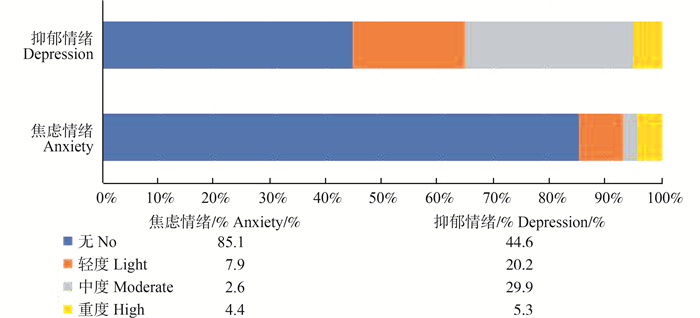A study on the prevalence rate of anxiety and depression status and influencing factors of COVID-19 patients in Fangcang shelter hospitals in Hainan
-
摘要:
目的 调查海南省COVID-19疫情期间三亚方舱医院COVID-19患者的焦虑和抑郁现患率及相关影响因素。 方法 2022年8―10月,通过问卷星网络平台对收治于海南省三亚第二方舱医院的COVID-19轻型患者和无症状感染者进行心理状况问卷调查。焦虑及抑郁的判定及严重程度分别通过焦虑自评量表和抑郁自评量表评估。采用多因素logistic回归分析模型分析影响焦虑、抑郁发生的因素。 结果 在纳入的569例患者中,焦虑和抑郁的整体检出率分别为14.9%和55.4%,以轻、中度为主。多因素logistic回归分析模型分析结果显示,女性、已婚者、饮酒及存在既往慢性病病史的患者更易出现焦虑情绪(均P<0.05)。已婚者、体力劳动者及独居者更易出现抑郁情绪,而经常参加体育锻炼者出现抑郁情绪的风险较低(均P<0.05)。 结论 COVID-19疫情期间,方舱医院内患者焦虑和抑郁不良情绪的患病率高,对高风险人群的不良心理状况应依据高危和诱发因素进行早期识别及干预。 Abstract:Objective To investigate the anxiety and depression status of asymptomatic and light COVID-19 patients admitted to Fangcang shelter hospitals in Hainan during the COVID-19 outbreak, and analyze the related influencing factors. Methods From August to October 2022, an online survey of anxiety and depression status using the Questionnaire Star program was conducted. The severity of anxiety and depression were assessed by Self-Rating Anxiety Scale and Self-Rating Depression Scale, respectively. A multivariable logistic regression model was used to analyze the influencing factors. Results Of the 569 patients included, 14.9% and 55.4% had COVID-19-related anxiety and depression symptoms, mainly mild and moderate. Multivariable logistic regression analysis showed that female sex, being married, alcohol consumption and past medical history were independent risk factors for anxiety symptoms (all P < 0.05). Additionally, being married, manual occupation and living alone were risk factors, while frequent physical exercises appeared as protective factors (all P < 0.05) related to depression symptoms. Conclusions The COVID-19 outbreak resulted in a related widespread increase in anxiety and depression in patients admitted to Fangcang shelter hospitals, and early identification and intervention of adverse psychological status in high-risk groups should be achieved. -
Key words:
- COVID-19 /
- Fangcang shelter hospitals /
- Anxiety /
- Depression /
- Adverse psychological status
-
表 1 方舱医院569名无症状感染者和轻型患者的一般情况
Table 1. Basic information of 569 asymptomatic and light COVID-19 patients admitted to Fangcang shelter hospitals
项目Factor 人数(占比/%) Number of people (proportion/%) 年龄组/岁Age group/years <20 106(18.6) 20~<40 223(39.2) 40~<60 205(36.0) ≥60 35(6.2) 性别Gender 男Male 295(51.8) 女Female 274(48.2) 民族Ethnicity 汉族Han 508(89.3) 其他Others 61(10.7) 文化程度Education level 初中及以下Junior middle school or below 296(52.0) 高中或中专Higher school or technical school 150(26.4) 大学及以上University and above 123(21.6) 婚姻状况Marital status 已婚Married 327(57.5) 其他(离异、丧偶、未婚等)Others (divorced, widowed, unmarried, et al) 242(42.5) 居住状况Residential type 同居(与家人或他人同居)Living together (with family or others) 499(87.7) 独居Living alone 70(12.3) 工作性质Work-related nature 脑力劳动为主Mental labor 204(35.9) 轻中度体力劳动为主Light and moderate physical labor 330(58.0) 重度体力劳动为主Heavy physical labor 35(6.2) 吸烟Smoking 110(19.3) 饮酒Drinking 107(18.8) 经常参加体育锻炼Regular physical exercise 162(28.5) 既往慢性病病史Previous chronic disease history 35(6.2) 注:既往慢性病病史包括恶性肿瘤、冠状动脉粥样硬化性心脏病(冠心病)、高血压、糖尿病、脑卒中、精神类疾病及痴呆。
Note: previous chronic disease history included malignant neoplasm, coronary heart disease, hypertension, diabetes, stroke, psychiatric disorders, and dementia.表 2 方舱医院不同特征无症状感染者和轻型患者焦虑、抑郁情绪的检出情况
Table 2. Detection of anxiety and depression in patients with different characteristics in Fangcang helter hospitals
变量Variable 焦虑情绪Anxiety 抑郁情绪Depression 无 ① No ① 有 ① Yes ① P值value 无 ① No ① 有 ① Yes ① P值value 年龄组/岁Age group/years 0.009 <0.001 <20 101(95.3) 5(4.7) 67(63.2) 39(36.8) 20~<40 186(83.4) 37(16.6) 95(42.6) 128(57.4) 40~<60 170(82.9) 35(17.1) 80(39.0) 125(61.0) ≥60 27(77.1) 8(22.9) 12(34.3) 23(65.7) 性别Gender 0.033 0.287 男Male 260(88.1) 35(11.9) 138(46.8) 157(53.2) 女Female 224(81.8) 50(18.2) 116(42.3) 158(57.7) 民族Ethnicity 0.473 0.450 汉族Han 434(85.4) 74(14.6) 224(44.1) 284(55.9) 其他Others 50(82.0) 11(18.0) 30(49.2) 31(50.8) 文化程度Education level 0.260 <0.001 初中及以下Junior middle school or below 258(87.2) 38(12.8) 109(36.8) 187(63.2) 高中或中专Higher school or technical school 122(81.3) 28(18.7) 69(46.0) 81(54.0) 大学及以上University and above 104(84.6) 19(15.4) 76(61.8) 47(38.2) 婚姻状况Marital status 0.002 <0.001 已婚Married 265(81.0) 62(19.0) 124(37.9) 203(62.1) 其他(离异、丧偶、未婚等)Others (divorced, widowed, unmarried) 219(90.5) 23(9.5) 130(53.7) 112(46.3) 居住状况Residential type 0.379 0.018 同居(与家人或他人同居)Living together (with family or others) 422(84.6) 77(15.4) 232(46.5) 267(53.5) 独居Living alone 62(88.6) 8(11.4) 22(31.4) 48(68.6) 工作性质Work-related nature 0.037 <0.001 脑力劳动为主Mental labor 182(89.2) 22(10.8) 128(62.7) 76(37.3) 轻中度体力劳动为主Light and moderate physical labor 270(81.8) 60(18.2) 119(36.1) 211(63.9) 重度体力劳动为主Heavy physical labor 32(91.4) 3(8.6) 7(20.0) 28(80.0) 吸烟Smoking 0.288 0.507 否No 394(85.8) 65(14.2) 208(45.3) 251(54.7) 是Yes 90(81.8) 20(18.2) 46(41.8) 64(58.2) 饮酒Drinking 0.003 0.417 否No 403(87.2) 59(12.8) 210(45.5) 252(54.5) 是Yes 81(75.7) 26(24.3) 44(41.1) 63(58.9) 经常参加体育锻炼Regular physical exercise 0.958 0.029 否No 346(85.0) 61(15.0) 170(41.8) 237(58.2) 是Yes 138(85.2) 24(14.8) 84(51.9) 78(48.1) 既往慢性病病史Previous chronic disease history <0.001 0.105 否No 462(86.5) 72(13.5) 243(45.5) 291(54.5) 是Yes 22(62.9) 13(37.1) 11(31.4) 24(68.6) 注:既往慢性病病史包括恶性肿瘤、冠状动脉粥样硬化心脏病(冠心病)、高血压、糖尿病、脑卒中、精神类疾病及痴呆。
①以[人数(占比/%)]表示。
Note: Previous chronic disease history included malignant neoplasm, coronary heart disease, hypertension, diabetes, stroke, psychiatric disorders, and dementia.
① [Number of people (proportion /%)].表 3 方舱医院无症状感染者和轻型患者焦虑、抑郁多因素logistic回归模型分析
Table 3. Multivariate logistic regression analysis of influencing factors for anxiety and depression status in patients of Fangcang shelter hospitals
变量Variable β值
valuesx Wald
χ2值valueOR值
value95% CI P值
value焦虑Anxiety 性别Gender 男Male 1.000 女Female 1.048 0.300 12.183 2.851 1.583~5.135 0.001 婚姻状况Marital status 其他(离异、丧偶、未婚等)Others (divorced, widowed, unmarried) 1.000 已婚Married 0.651 0.268 5.899 1.917 1.134~3.241 0.015 饮酒Drinking 否No 1.000 是Yes 1.306 0.333 15.387 3.690 1.922~7.086 <0.001 既往慢性病病史Previous chronic disease history 否No 1.000 是Yes 1.323 0.395 11.210 3.755 1.731~8.148 0.001 抑郁Depression 婚姻状况Marital status 其他(离异、丧偶、未婚等)Others (divorced, widowed, unmarried) 1.000 已婚Married 0.403 0.189 4.541 1.496 1.033~2.167 0.033 工作性质Work-related nature 脑力劳动为主Mental labor 1.000 轻中度体力劳动为主Light and moderate physical labor 0.963 0.195 24.314 2.618 1.786~3.839 <0.001 重度体力劳动为主Heavy physical labor 1.693 0.454 13.890 5.434 2.231~13.235 <0.001 居住状况Residential type 同居(与家人或他人同居)Living together (with family or others) 1.000 独居Living alone 0.676 0.292 5.373 1.966 1.110~3.480 0.020 经常参加体育锻炼Regular physical exercise 否No 1.000 是Yes -0.413 0.196 4.413 0.662 0.450~0.973 0.036 焦虑伴随抑郁Anxiety accompanied by depression 性别Gender 男Male 女Female 1.292 0.327 15.609 3.640 1.918~6.910 <0.001 婚姻状况Marital status 其他(离异、丧偶、未婚等) Others (divorced, widowed, unmarried, et al) 1.000 已婚Married 0.730 0.282 6.676 2.074 1.193~3.607 0.010 饮酒Drinking 否No 1.000 是Yes 1.532 0.354 18.723 4.629 2.312~9.268 <0.001 既往慢性病病史Previous chronic disease history 否No 1.000 是Yes 0.964 0.424 5.185 2.623 1.144~6.017 0.023 注:既往慢性病病史包括恶性肿瘤、冠状动脉粥样硬化性心脏病(冠心病)、高血压、糖尿病、脑卒中、精神类疾病及痴呆。
Note: Previous chronic disease history included malignant neoplasm, coronary heart disease, hypertension, diabetes, stroke, psychiatric disorders, and dementia. -
[1] Salanti G, Peter N, Tonia T, et al. The Impact of the COVID-19 pandemic and associated control measures on the mental health of the general population: a systematic review and dose-response meta-analysis[J]. Ann Intern Med, 2022, 175(11): 1560-1571. DOI: 10.7326/M22-1507. [2] 李想, 邓艳萍, 付国东, 等. 新冠肺炎疫情期间普通病房患者的焦虑抑郁情绪[J]. 中国心理卫生杂志, 2020, 34(8): 720-722. DOI: 10.3969/j.issn.1000-6729.2020.8.016.Li X, Deng YP, Fu GD, et al. Anxiety and depression of patients in general ward during the COVID-19 epidemic[J]. Chinese Mental Health Journal, 2020, 34(8): 720-722. DOI: 10.3969/j.issn.1000-6729.2020.8.016. [3] Luo M, Guo L, Yu M, et al. The psychological and mental impact of coronavirus disease 2019 (COVID-19) on medical staff and general public - a systematic review and meta-analysis[J]. Psychiatry Res, 2020, 291: 113190. DOI: 10.1016/j.psychres.2020.113190. [4] 翟文海, 张琼, 胡卫, 等. 新冠肺炎疫情发生前后中国大学生焦虑症状及相关因素的meta分析[J]. 中国心理卫生杂志, 2022, 36(7): 626-632. DOI: 10.3969/j.issn.1000-6729.2022.07.014.Zhai WH, Zhang Q, Hu W, et al. A meta-analysis of anxiety symptoms and related factors in Chinese college students before and after the COVID-19 epidemic[J]. Chinese Mental Health Journal, 2022, 36(7): 626-632. DOI: 10.3969/j.issn.1000-6729.2022.07.014. [5] 戴立磊, 黄莹, 杜晖, 等. 新冠肺炎疫情影响下长期居家人员的情绪及睡眠质量的调查及危险因素分析[J]. 临床精神医学杂志, 2021, 31(2): 120-123. DOI: 10.3969/j.issn.1005-3220.2021.02.009.Dai LL, Huang Y, Du H, et al. The mood and sleep quality of long-term home residents under the influence of COVID-19 epidemic and its risk factors[J]. J Clin Psychiatry, 2021, 31(2): 120-123. DOI: 10.3969/j.issn.1005-3220.2021.02.009. [6] 杨道良, 陈龙云, 顾俊杰, 等. 方舱医院新型冠状病毒肺炎患者心理健康状况及心理干预[J]. 中国健康心理学杂志, 2021, 29(4): 560-564. DOI: 10.13342/j.cnki.cjhp.2021.04.018.Yang DL, Chen LY, Gu JJ, et al. Psychological status and psychological intervention of COVID-19 patients in Fangcang shelter hospital[J]. China Journal of Health Psychology, 2021, 29(4): 560-564. DOI: 10.13342/j.cnki.cjhp.2021.04.018. [7] 李文浩, 黄媛, 王春兰, 等. 方舱医院新型冠状病毒肺炎患者焦虑状况[J]. 中国健康心理学杂志, 2020, 28(8): 1191-1194. DOI: 10.13342/j.cnki.cjhp.2020.08.017.Li WH, Huang Y, Wang CL, et al. Anxiety investigation among COVID-19 patients in a cabin hospital[J]. China Journal of Health Psychology, 2020, 28(8): 1191-1194. DOI: 10.13342/j.cnki.cjhp.2020.08.017. [8] Chen N, Zhou M, Dong X, et al. Epidemiological and clinical characteristics of 99 cases of 2019 novel coronavirus pneumonia in Wuhan, China: a descriptive study[J]. Lancet, 2020, 395(10223): 507-513. DOI: 10.1016/S0140-6736(20)30211-7. [9] 傅燚, 孙跃喜, 张宸韬, 等. 上海市方舱医院新型冠状病毒肺炎患者心理健康状况调查及影响因素研究[J]. 同济大学学报(医学版), 2022, 43(3): 303-309. DOI: 10.12289/j.issn.1008-0392.22173.Fu Y, Sun YX, Zhang CT, et al. A survey of mental health and influencing factors of COVID-19 patients in fangcang shelter hospitals in Shanghai[J]. Journal of Tongji University(Medical Science), 2022, 43(3): 303-309. DOI: 10.12289/j.issn.1008-0392.22173. [10] 王畅, 李文浩, 王大虎, 等. 武汉市某方舱医院新冠肺炎患者心理健康状况调查[J]. 预防医学论坛, 2021, 27(8): 583-586. DOI: 10.16406/j.pmt.issn.1672-9153.2021.08.007.Wang C, Li WH, Wang DH, et al. Investigation on mental health status of COVID-19 patients in a cabin hospital, Wuhan City[J]. Prev Med Trib, 2021, 27(8): 583-586. DOI: 10.16406/j.pmt.issn.1672-9153.2021.08.007. [11] 周国红, 尹良爽, 朱文礼, 等. 武汉方舱医院患者的心理状况及心理健康异常影响因素分析[J]. 安徽医学, 2020, 41(9): 1091-1094. DOI: 10.3969/j.issn.1000-0399.2020.09.028.Zhou GH, Yin LS, Zhu WL, et al. Analysis of the psychological status of patients and factors affecting mental health abnormalities in Wuhan Fangcang Hospital[J]. Anhui Yixue, 2020, 41(9): 1091-1094. DOI: 10.3969/j.issn.1000-0399.2020.09.028. [12] 程娟, 陈卿, 刘成锋, 等. 2020年新冠肺炎疫情期间深圳市居民抑郁、焦虑情绪及其影响因素分析[J]. 预防医学情报杂志, 2022, 38(10): 1375-1381, 1387.Cheng J, Chen Q, Liu CF, et al. Depression and anxiety in Shenzhen and its influencing factors during COVID-19 epidemic period[J]. J Prev Med Inf, 2022, 38(10): 1375-1381, 1387. [13] Zhou X, Bi B, Zheng L, et al. The prevalence and risk factors for depression symptoms in a rural Chinese sample population[J]. PLoS One, 2014, 9(6): e99692. DOI: 10.1371/journal.pone.0099692. [14] Yu W, Singh SS, Calhoun S, et al. Generalized anxiety disorder in urban China: prevalence, awareness, and disease burden[J]. J Affect Disord, 2018, 234: 89-96. DOI: 10.1016/j.jad.2018.02.012. [15] Lynch SM, Guo G, Gibson DS, et al. Role of senescence and aging in SARS-CoV-2 infection and COVID-19 disease[J]. Cell, 2021, 10(12): 3367. DOI: 10.3390/cells10123367. [16] Dong Y, Wang X, Zhou Y, et al. Hypothalamus-pituitary-adrenal axis imbalance and inflammation contribute to sex differences in separation- and restraint-induced depression[J]. Horm Behav, 2020, 122: 104741. DOI: 10.1016/j.yhbeh.2020.104741. [17] 冯芳, 钱振中, 胡彩云, 等. 安徽省某农村地区独居老年人焦虑现状及影响因素研究[J]. 中华疾病控制杂志, 2016, 20(9): 929-931, 970. DOI: 10.16462/j.cnki.zhjbkz.2016.09.017.Feng F, Qian ZZ, Hu CY, et al. Study on the anxiety and its associated factors among elderly living alone in one rural area of Anhui Province[J]. Chin J Dis Control Prev, 2016, 20(9): 929-931, 970. DOI: 10.16462/j.cnki.zhjbkz.2016.09.017. [18] 齐士格, 王志会, 王临虹. 慢性病与新型冠状病毒肺炎相互影响及其防控管理策略[J]. 中华医学杂志, 2020, 100(44): 3551-3555. DOI: 10.3760/cma.j.cn112137-20200824-02449.Qi SG, Wang ZH, Wang LH. Interaction between chronic diseases and novel coronavirus and its prevention and control management strategies[J]. Natl Med J Chin, 2020, 100(44): 3551-3555. DOI: 10.3760/cma.j.cn112137-20200824-02449. [19] 王小龙, 张春晶, 于海涛, 等. 短期低剂量饮酒后戒断改变雄性大鼠肠道微生物菌群并与焦虑样行为相关[J]. 中国生物化学与分子生物学报, 2021, 37(5): 653-661. DOI: 10.13865/j.cnki.cjbmb.2021.02.1453.Wang XL, Zhang CJ, Yu HT, et al. The gut microbiota changed by short-term low-dose ethanol withdrawal and related to the anxiety like behavior in male rats[J]. Chine J Biochem Mol Biol, 2021, 37(5): 653-661. DOI: 10.13865/j.cnki.cjbmb.2021.02.1453. [20] Rebar AL, Stanton R, Geard D, et al. A meta-meta-analysis of the effect of physical activity on depression and anxiety in non-clinical adult populations[J]. Health Psychol Rev, 2015, 9(3): 366-378. DOI: 10.1080/17437199.2015.1022901. -





 下载:
下载:

